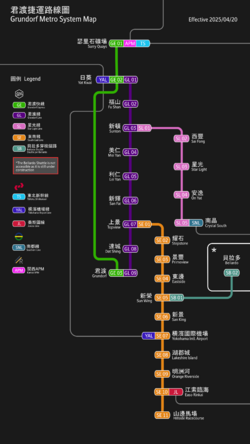Grundorf Metro
Views
Actions
Namespaces
Variants
Tools
| Locale | Southern Joban, Grundorf Island |
|---|---|
| Transit Type | Rapid Transit |
| Number of lines | 4 |
Grundorf Corporation, commonly refered as Grundorf Metro (GM; Chinese 君渡捷運), is a railway company in Joban, operating the South Eastern Joban Region that provides crucial access from Grundorf Island to the Southern Joban. Its headquarters are currently located in Yat Kwai, one of the major hubs of the Grundorf Area.
History
In 1982, a railway line is proposed and subsequently built that connects between Sunton and On Yat, which was the biggest port in the Grundorf territory.
In 2007, the government of Joban proposed an idea to develop a Central Business District in the island of Sung Tak and need new transit lines to go through the island. During this time the state of Grundorf is also looking for a way to increase tourism and boost the economy but are unable to fund themselves any sort of public transit, as such planning work quickly begins on creating a new railway line that connects from the Grundorf Island to Sung Tak.
In 2009, both Grundorf Metro and Rigel Corporation are rewarded to build a rapid transit towards Sung Tak, this would later become Grundorf Line and Metropolis Line respectively
In 2016, the Grundorf Line is officially opened from Grundorf to Sung Tak. The previous line that heads towards the Port is renamed to Star Light Line.
Due to severe delays on the Rigel Metropolis Line, Sung Tak did not immediately gain significant development and the lines are mostly used for Grundorf resident to travel between the state.
In July 2023, a major milestone has been reached as the Star Light Line has been extended to Crystal South Station, a new station that will interchange with the SXR Southern Line, finally forming an easily accessible public transit to Grundorf.
In late 2023, helped by additional funds provided from the Yokohama Aiport Company, Grundorf Metro had to deliver a new commuter-line that would connect Grundorf to the omonym airport in a short time. In just 3 months, GM had build the new South East Line, a 10 station underground commuter railway. Thanks to the line, the Eastern Maiko-Lakeshire region has been revived: the line gave new opportunities to small businesses and cities to gain more popularity. The stations of the South East Line were mostly rushed and lacked basic station facilities, which led Grundorf Corporation to start a refurbishing movement, one year after the line opening. Stations like Lakeshire, Eastside, Primeview and Sun Wing were completely rebuilt. Others like Orange Riverside, Hillside Racecourse and Yokohama recieved major improvements. SEL stations had now what they promised since the start: More space for advertisements, waiting room, more operational facilities, less leakages, new branding and in station announcements, which are currently being experimented in limited stations. Sun Wing is expected to allocate the future Bellardo Shuttle, which will connect the Italian Mainland (as we can see from the blocked tunnel).
The company later went into severe financial problems, which led them to hold numerous meetings with other Jobanese Companies. The media speculates that Grundorf might have done some secret agreements regarding the infamous Rigel Monopoly Theory, and that they got funds for supporting them. Grundorf Metro managed to resolve all those financial issues and overhaul their Headquarters at Surry Quays.
To regain some attention, the company decided to participate in the funding campaign hosted by the city of Surry Quays and won. Thus, after researching in monorail technology, in early 2025, the company launched the first automatic monorail system, the Surry Quays Monorail Transit, or SQMT. The first line opened (Line 1) connects the Northern Heights school, the railway station, the infamous Surry Quays Stock Exchange and the newly introduced Opera Mall. The SQMT has recieved the most passengers of Grundorf Metro in over a year. Thanks to the opening of the monorail, a big City Infrastructure Development was also initiated, with a million funds invested in expanding and modernising the cities of the Jobanese region .

